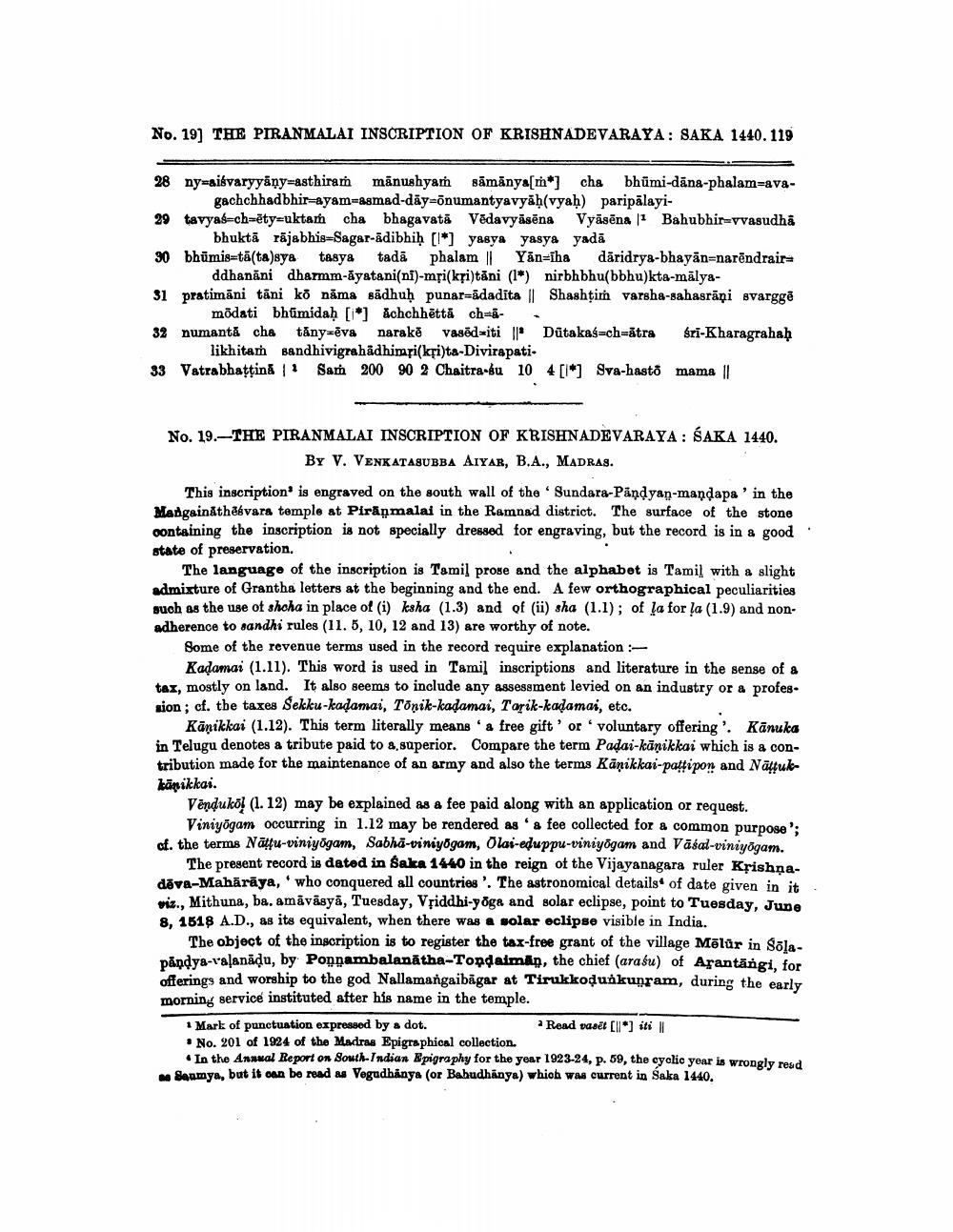________________
No. 19] THE PIRANMALAI INSCRIPTION OF KRISHNADEVARAYA: SAKA 1440. 119
28 ny-aiśvaryyaṇy-asthiram manushyam sāmānya[m*] cha bhumi-dana-phalam-avagachchhadbhir ayam-aamad-day-önumantyavyäḥ(vyab) paripälayi
29 tavyas-ch-ety-uktam cha bhagavatā Vēdavyāsēna Vyāsēna | Bahubhir-vvasudha bhuktā rājabhis-Sagar-ädibhiḥ [*] yasya yasya yadā
30 bhumis-tä (ta)sya tasya tada phalam || Yan-iha daridrya-bhayan-narendrair= ddhanani dharmm-ayatani(ni)-mri(kṛi)tāni (1) nirbhbhu(bbhu)kta-malya
31 pratimäni täni ko nama sadhuḥ punar-adadīta || Shashtim varsha-sahasrani svargge mōdati bhūmidaḥ [*] achchhettä ch-a
32 numantă cha tany-ēva narakē vased-iti || Dūtakaś=ch=ātra śri-Kharagrahaḥ likhitah sandhivigrah&dhimri(kri)ta-Divirapati
33 Vatrabhaṭṭina | Sam 200 90 2 Chaitra-su 10 4 [*] Sva-hasto mama ||
No. 19. THE PIRANMALAI INSCRIPTION OF KRISHNADEVARAYA: SAKA 1440. BY V. VENKATASUBBA AIYAR, B.A., MADRAS.
6
This inscription is engraved on the south wall of the Sundara-Pandyan-manḍapa' in the Mangainathe vara temple at Piranmalai in the Ramnad district. The surface of the stone containing the inscription is not specially dressed for engraving, but the record is in a good state of preservation.
The language of the inscription is Tamil prose and the alphabet is Tamil with a slight admixture of Grantha letters at the beginning and the end. A few orthographical peculiarities such as the use of shcha in place of (i) ksha (1.3) and of (ii) sha (1.1); of la for la (1.9) and nonadherence to sandhi rules (11. 5, 10, 12 and 13) are worthy of note.
Some of the revenue terms used in the record require explanation :
Kadamai (1.11). This word is used in Tamil inscriptions and literature in the sense of a tax, mostly on land. It also seems to include any assessment levied on an industry or a profes sion; cf. the taxes Sekku-kadamai, Tonik-kadamai, Tarik-kadamai, etc.
Kānikkai (1.12). This term literally means ' a free gift' or 'voluntary offering'. Kānuka in Telugu denotes a tribute paid to a superior. Compare the term Padai-kanikkai which is a contribution made for the maintenance of an army and also the terms Kanikkai-pattipon and Nattukkāņikkai.
Vendukōl (1.12) may be explained as a fee paid along with an application or request. Viniyogam occurring in 1.12 may be rendered as a fee collected for a common purpose'; of. the terms Nattu-viniyogam, Sabhä-viniyogam, Olai-eduppu-viniyogam and Vasal-viniyogam. The present record is dated in Saka 1440 in the reign of the Vijayanagara ruler Krishnadēva-Mahārāya, ' who conquered all countries'. The astronomical details of date given in it viz., Mithuna, ba. amaväsyä, Tuesday, Vriddhi-yoga and solar eclipse, point to Tuesday, June 8, 1518 A.D., as its equivalent, when there was a solar eclipse visible in India.
The object of the inscription is to register the tax-free grant of the village Mölür in Sōlapandya-valanādu, by Ponnambalanatha-Topḍaiman, the chief (arasu) of Arantangi, for offerings and worship to the god Nallamangaibagar at Tirukkoḍunkuṇram, during the early morning service instituted after his name in the temple.
1 Mark of punctuation expressed by a dot.
Read vaset [*] iti ||
No. 201 of 1924 of the Madras Epigraphical collection.
In the Annual Report on South-Indian Epigraphy for the year 1923-24, p. 59, the cyclic year is wrongly read as Saumya, but it can be read as Vegudhanya (or Babudhanya) which was current in Saka 1440.




